Nuno Espírito Santo’s time at Tottenham Hotspur went horribly wrong. After sitting top of the Premier League with the Lilywhites within the first few games of the season, having beaten champions Manchester City on the opening week, things were looking promising.
However, by November, Spurs were sitting in eighth, ten points adrift of top spot. After a 3-0 defeat suffered at the hands of a Manchester United side who were struggling in their own regard, the board took action.
Nuno was relieved of his duties and replaced by Antonio Conte. It was the first time the Portuguese coach had been out of work in English football, having had wonderful success with Wolverhampton Wanderers, guiding the side to the UEFA Europa League in 2019 in their first season back in the top flight.
The former Porto head coach had earned a reputation for playing highly conservative football and building a solid defensive foundation, making Wolves a team that nobody wanted to face.
Nevertheless, for reasons that are unknown, Nuno could not build this solidity in London and the defensive style of football didn’t quite click with the Tottenham Hotspur faithful.
Nuno took a sabbatical for eight months before getting back into the cruel world of football management, taking charge of Saudi Arabian giants Al-Ittihad in what may have seemed like an eyebrow-raising career choice at the time.
Regardless, six months into his tenure in the Middle East and Al-Ittihad are sitting just two points off league-leaders Al-Nassr who have just added Cristiano Ronaldo to their already stacked squad under the former Lyon boss Rudi Garcia.
The Jeddah-based club are in an early title race in the Saudi Professional League and have lost just once under the tactician’s tutelage, playing a style of football so alienated from what we have become accustomed to from a Nuno side.
This piece will be a tactical analysis of Nuno’s Al-Ittihad, in the form of a team scout report. It will be an analysis of the tactics that the former Wolves and Spurs boss has used with the Tigers thus far.
Formations
The UEFA Champions League-winning goalkeeper with Porto earned a reputation for playing an extremely well-drilled 3-4-3 at Molineux.
Often, the shape would convert into a 5-4-1 for large parts of Wolves’ games when Nuno’s men were sitting in a low block, making it really difficult for teams to break them down.
However, in his final campaign in the West Midlands, when performances and results had fallen off the edge of a cliff in comparison to the previous three seasons, Nuno looked to change Wolves’ formation, moving away from his preferred 3-4-3 to a slightly more expansive 4-2-3-1.
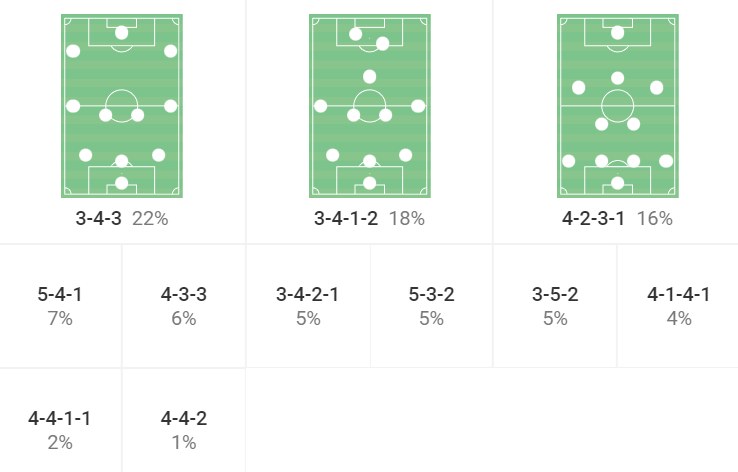
When Nuno took over at Spurs, following the sacking of the legendary Jose Mourinho, there was an expectation that the North London club would switch from a 4-2-3-1, which was primarily used under ‘The Special One’, to the new manager’s preferred 3-4-3. But this never happened.
Instead, Nuno opted to use a 4-3-3, perhaps believing that the team did not possess enough quality centre-backs to use a back three, although Conte disproved this theory in the proceeding months.
Upon taking charge of Al-Ittihad, it was anyone’s guess as to what formation the Portuguese pragmatist would deploy, but keeping in line with his recent tactical history, Nuno has deployed a 4-2-3-1, and to great success so far.
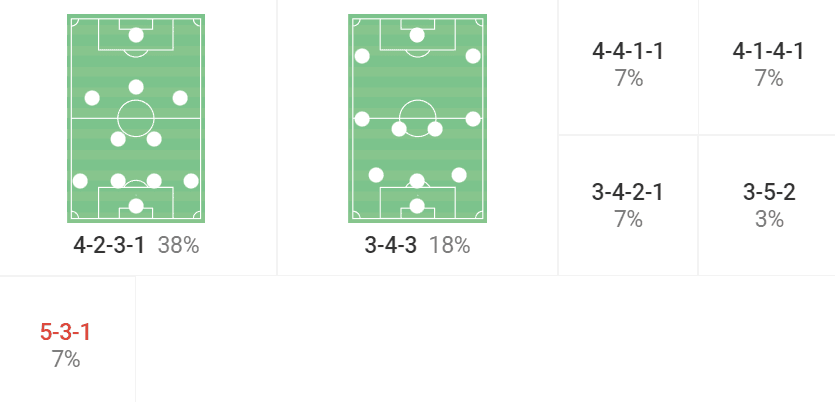
Nonetheless, formations have merely become a method to quantify the starting position of each player on a football pitch in the modern game, especially in possession.
As we will analyse in more detail in this team analysis, Al-Ittihad’s shape in possession resembles anything but a 4-2-3-1.
A new Nuno
In English football, Nuno earned a reputation for being a ‘defensive’ coach, using blistering counterattacks and solid defensive principles to make his sides tough to beat.
Where Wolves and Spurs fell down was when they were tasked with having much more of the ball than their opponents. This was far more prevalent with the latter club and was one of the main downfalls of Nuno’s reign at the Tottenham Hotspur Stadium.
Spurs looked void of attacking principles and struggled to create meaningful chances for players like Harry Kane and Heung-Min Son.
However, the manager’s eight-month-long spell out of the game seemed to be highly beneficial for the 48-year-old. His Al-Ittihad team play some of the best football in the Middle East right now and look so far removed stylistically from Nuno’s previous clubs.
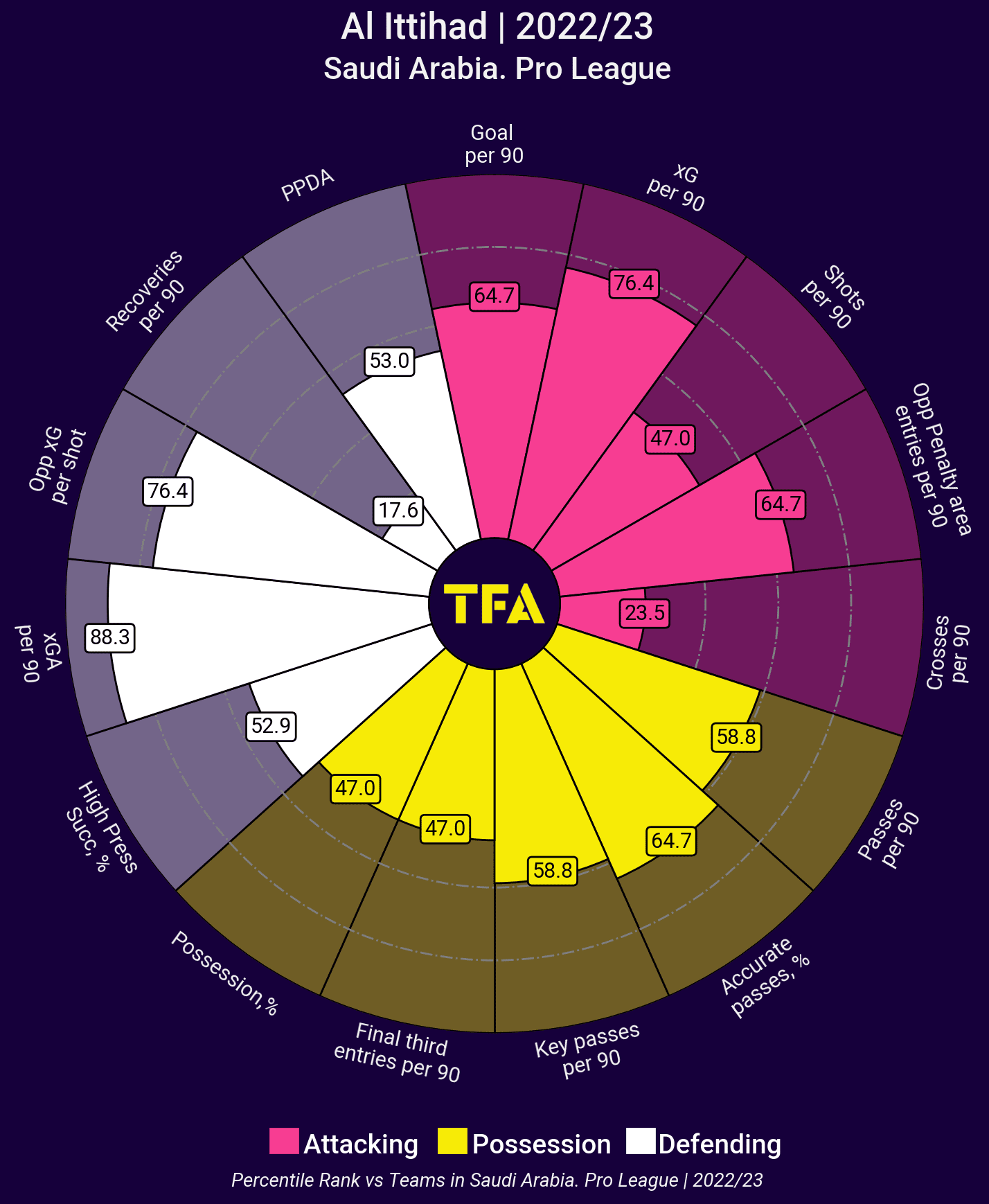
As we can see, Al-Ittihad rank above the league’s average on numerous attacking methods such as opposition penalty area entries per 90, passes per 90, accurate passes per 90, key passes per 90, xG per 90 and goals per 90.
The former goalkeeper has completely transformed his ideas of how the game should be played and the flowers of his new philosophy are blossoming at the King Abdullah Sport City Stadium.
The most important aspect of Nuno’s in-possession tactics in Saudi Arabia is constant off-the-ball movement to create chaos among the opposition when they are faced with a zonal defensive block.
Apart from the centre-backs and the goalkeeper, no player in the side has a fixed position and they are free to move all over the park…within reason.
For instance, Al-Ittihad create a lot of wide overloads, so it’s really common to see a triangle with the fullback, winger and number ’10’, but the movement isn’t limited so, often, the winger can hold the width with the fullback inverting and the midfielder sitting at the base, as well as many other combinations of this variation.
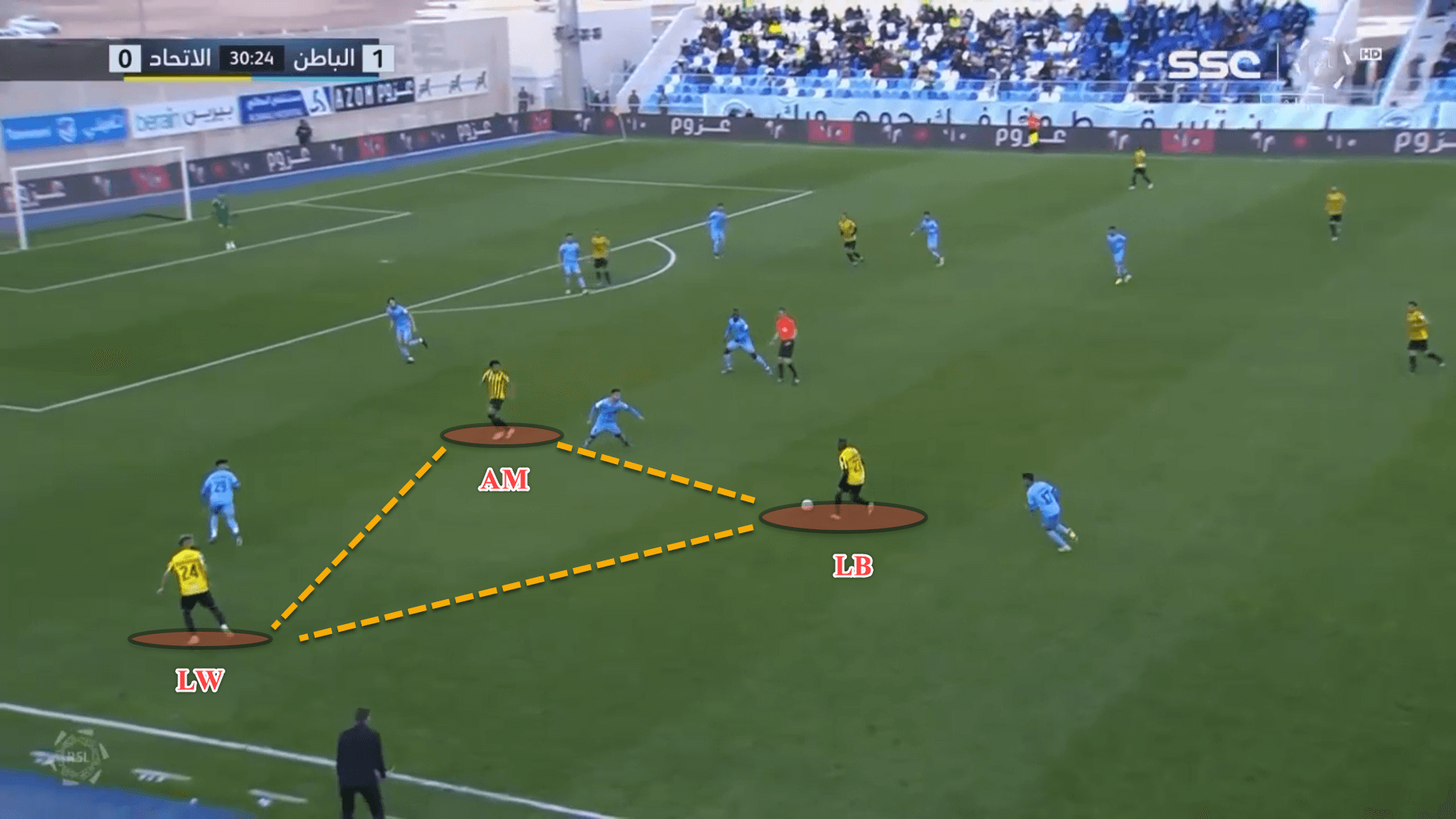
Here, the winger is holding the width on the left flank while the fullback has tucked into the halfspace, sitting at the base of a triangle behind the number ‘10’ Romarinho who is further ahead in the halfspace, attacking the depth behind the opposition’s backline.
These are three common traits that Al-Ittihad’s wide overloads have under Nuno. The coach wants at least one player making a run behind the defensive line in order to drag the defence with him, creating separation between the defence and the midfield lines.
Meanwhile, one player stays wide to stretch the opposition’s block horizontally to try and decompact the space between each player which also causes gaps to open up across the pitch.
Wide overloads created by the title challengers are not solely conditional to triangles. Many players can pull across the pitch to get involved.
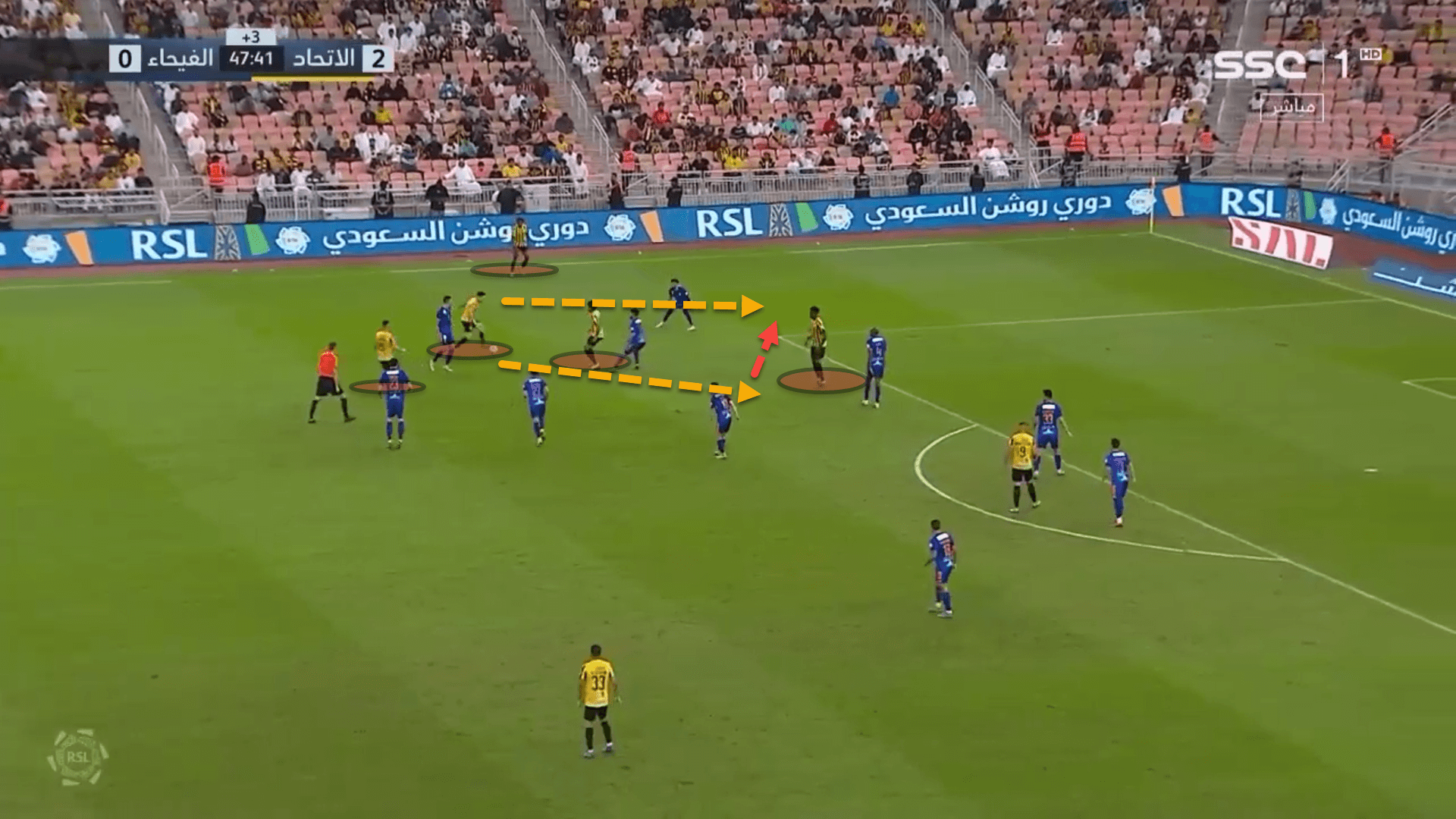
Even the ball-far winger pushes across to form these wide overloads for Al-Ittihad. The main objective for Nuno’s side is to have numerical superiority in these areas of the pitch.
By having more numbers than the opposition on one side, the attacking team can have a free man to play to and find with passes in behind using third-man runs to break down the defensive block.
In the previous image, Al-Ittihad had numerical superiority on the left and were able to use this to their advantage by playing to the free third man who was running in behind into the box. This exact scenario led to a goal once the ball did find its way into the penalty area.
Nevertheless, there is another benefit to using wide overloads. As a team will push bodies across to have numerical superiority, the defensive side shift their entire block over to the ball side to try and defend these situations.
When this occurs, there will be space on the far side of the pitch for a switch of the play. If the defensive team have locked down the wide space and Al-Ittihad are struggling to break through using an overload on the flanks, Nuno wants his players to switch the ball out to the opposite side.
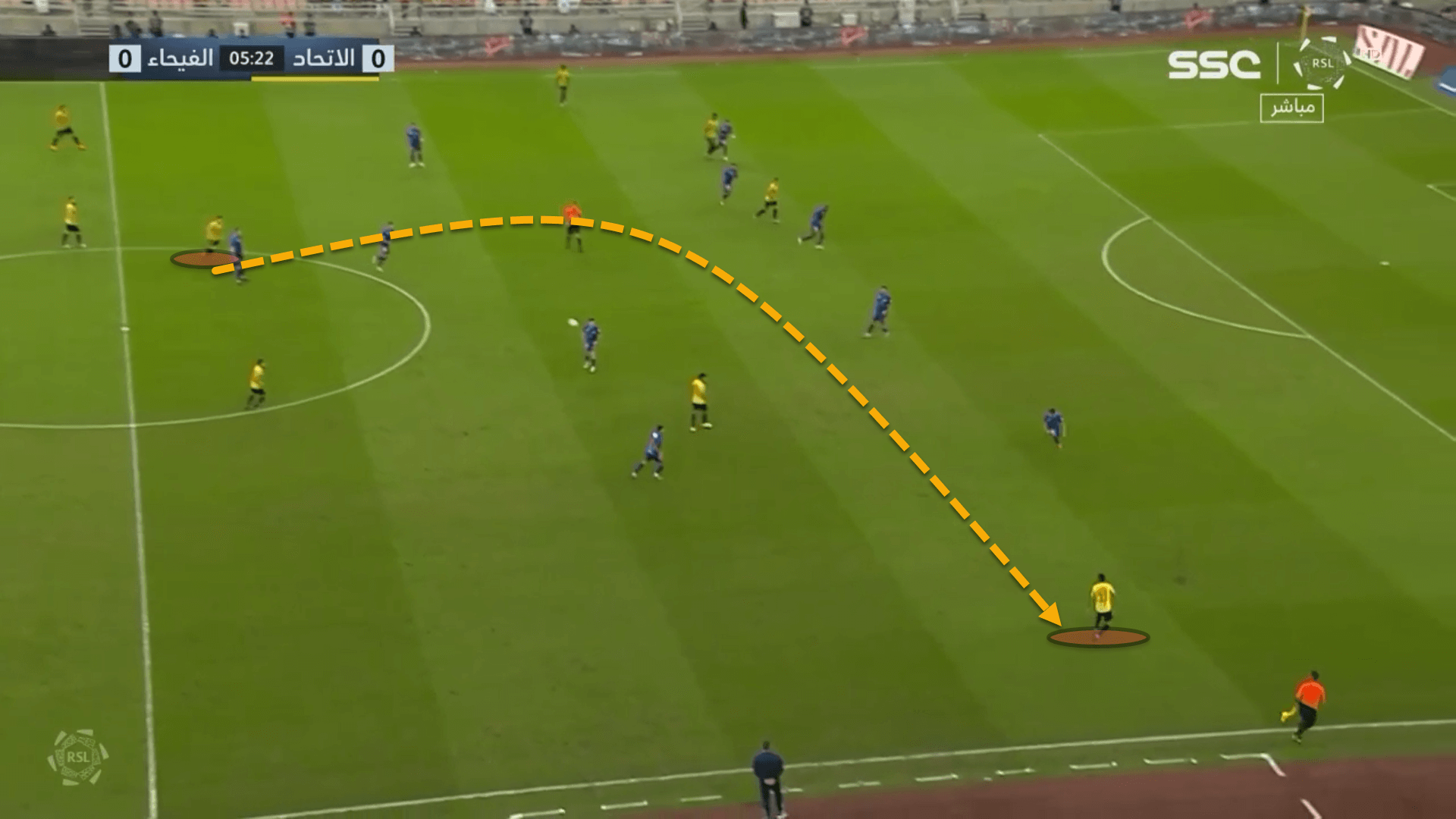
Normally, the ball-far fullback is the man who can be found in these positions, primarily because the winger on that side has drifted inside or pushed across to the opposite flank to get involved in the play.
This method is called ‘overloading to isolate’. Essentially, the team overload one side of the pitch, causing the opponent’s block to push across before they switch it out to the other with a diagonal ball to isolate the fullback in a 1v1 situation against his opposite number.
From there, it is merely a case of quality versus quality and if the player that the ball was switched to can beat his man, then Al-Ittihad can get themselves into dangerous goalscoring opportunities.
Countermovements and vertical play
By this point, it may seem as though Nuno has completely overhauled his tactical philosophy, becoming a coach who is hell-bent on ball retention and positional play to create chances.
This isn’t true. Al-Ittihad are not a possession-based side. In fact, this season, The Tigers have averaged just 49 percent of the ball per game in all competitions.
Al-Ittihad’s tactics in the attacking phase are not focused on being patient on the ball. Nuno wants his players to try and reach the opposition’s penalty area as quickly and as efficiently as possible. While wide overloads are the primary method used by the Middle Eastern giants to break down a defensive block, they will also try to play to players between the lines when applicable.
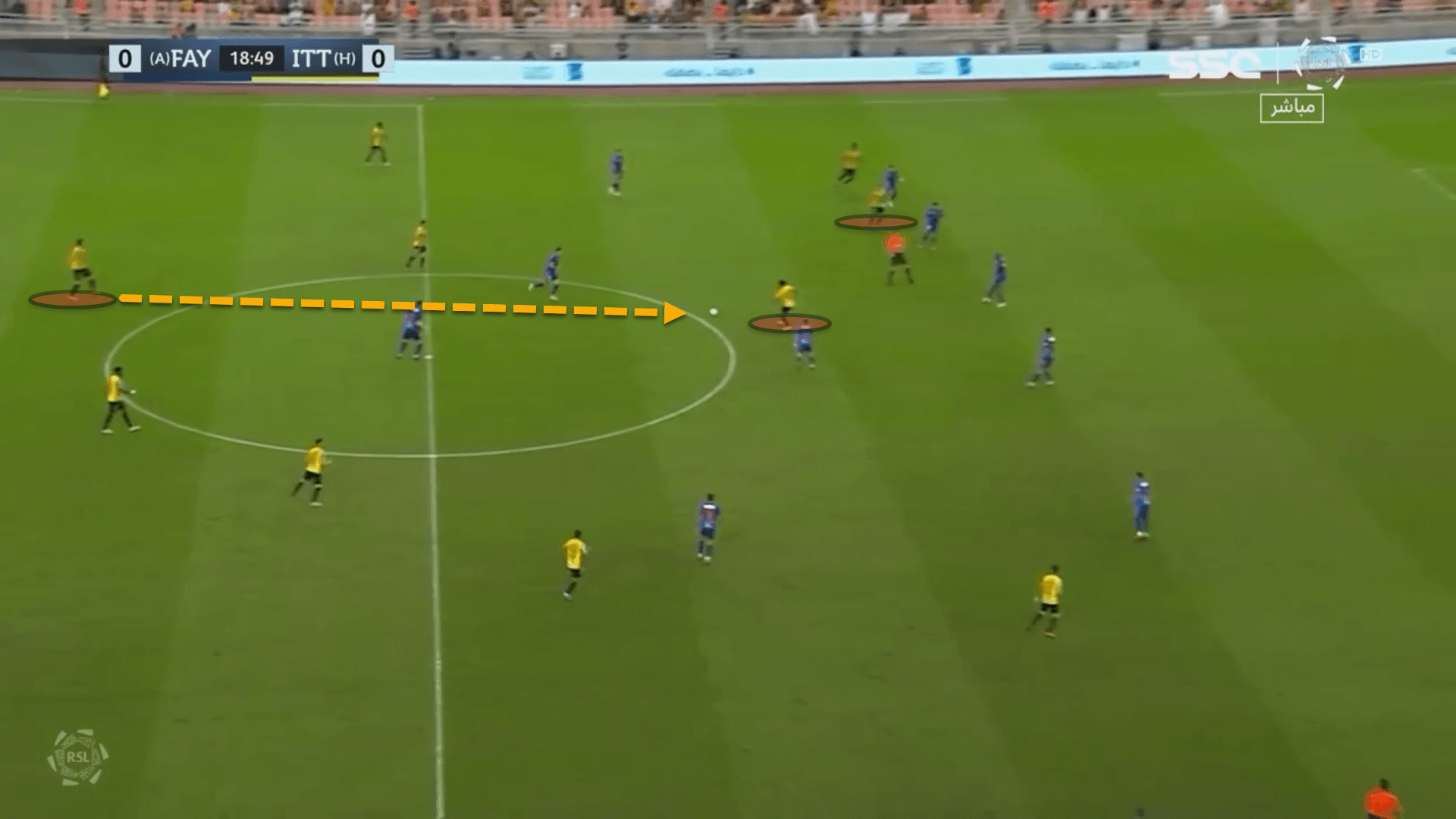
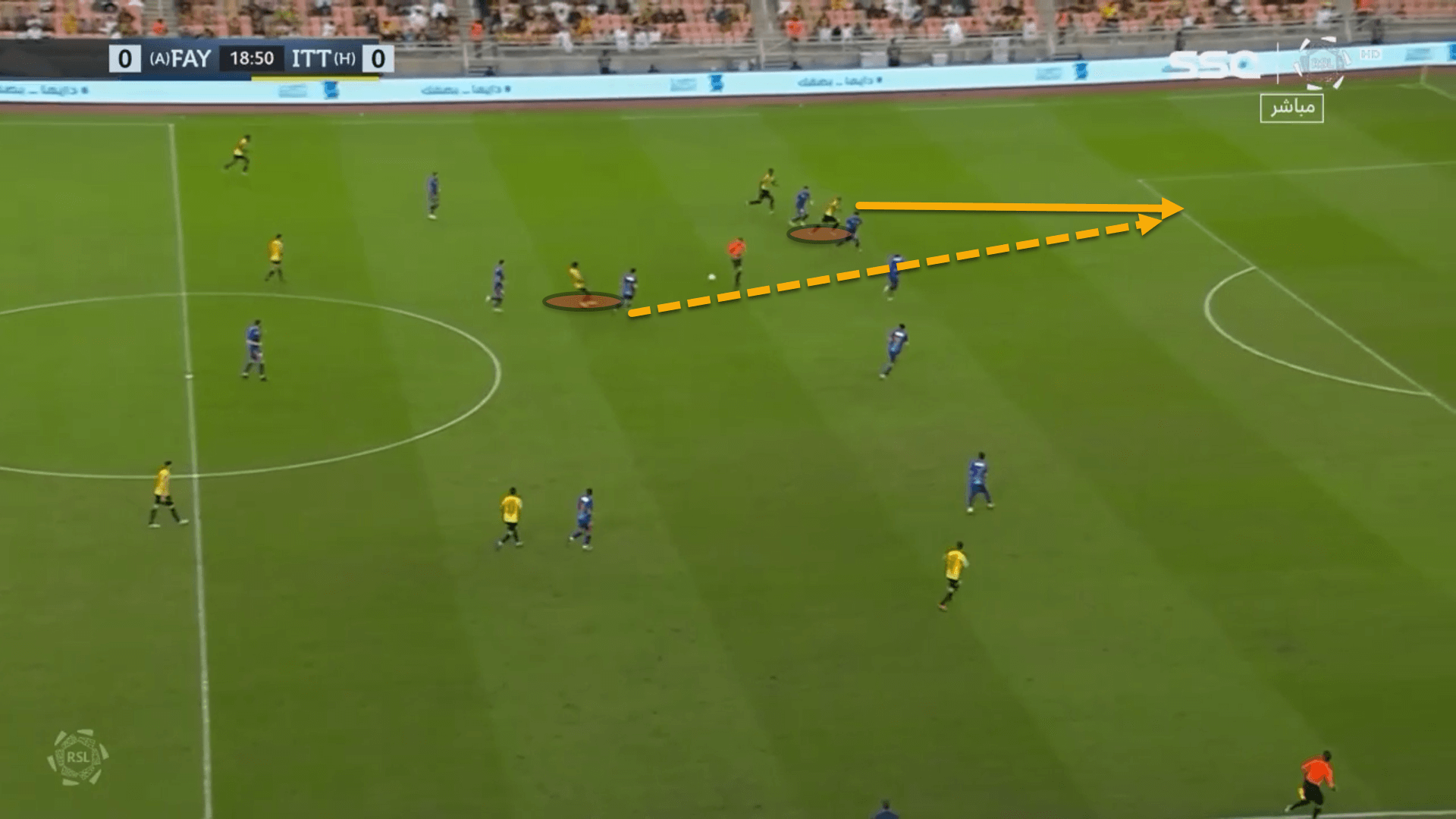
Here, a passing option in the middle of the park has opened up with the player having time and space to take the ball on the half-turn and play to a runner in behind. Al-Ittihad take advantage of this.
The opportunity to play these split passes behind the opponent’s midfield line are few and far between because most sides are compact and focus on cutting off passing lanes into these spaces in the central corridors, hence why Al-Ittihad play wider as there is generally room to operate out on the flanks.
However, to switch things up, Nuno is fine with his players playing balls over the top of the defensive line once there are runners attacking the depth, looking to get in behind. Often, these occur as a result of countermovements.
Countermovements are an excellent way to create space for runners behind the backline. Basically, one player, who is holding a position on the last line, drops short which drags one of the defenders out of the backline, causing a gap to open up. From there, another forward will begin moving in behind, hoping to be found with a ball over the top.
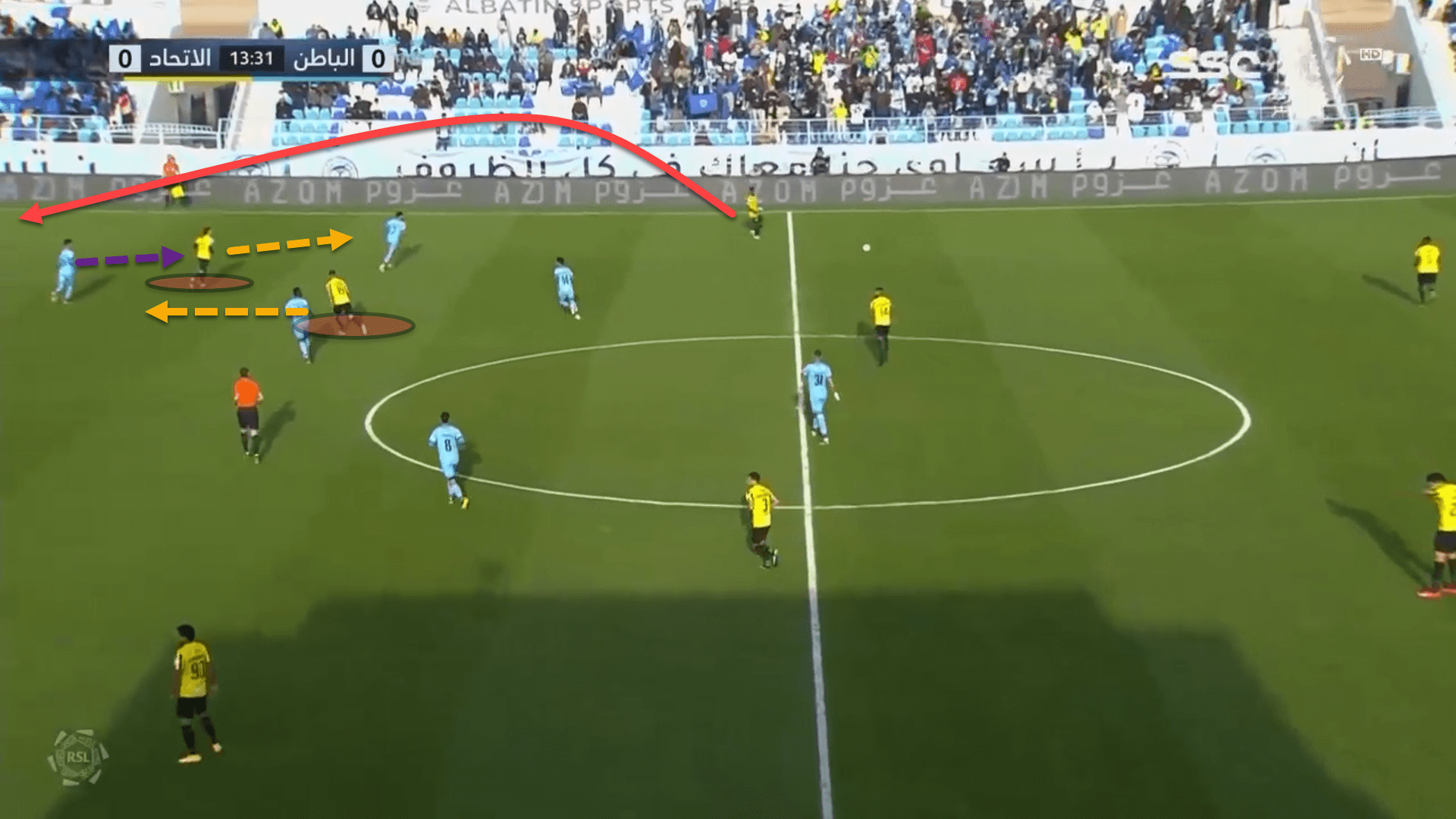
Here is an example of Al-Ittihad using countermovements to manipulate the opposition’s defensive line to create space for a runner from deep.
Helder Costa, a former player of Nuno Espírito Santo at Wolves, was positioned on the last line but dropped out, dragging his man with him and creating a free channel for the Al-Ittihad midfielder to run into and receive down the line from the fullback.
Sometimes, there doesn’t even need to be a countermovement for Al-Ittihad to play in behind. Once there is a player making a decent run on the shoulder of the opposition’s defender, Nuno is fine with direct balls over the top.
These passes typically come at an angle though. Regularly, players will try and hit deep crosses from the halfspaces or the flanks, meaning the ball will travel into the box at an angle for attackers to try and latch onto. We can see this from the side’s shots assists map this season portraying the chances that Nuno’s men have created.
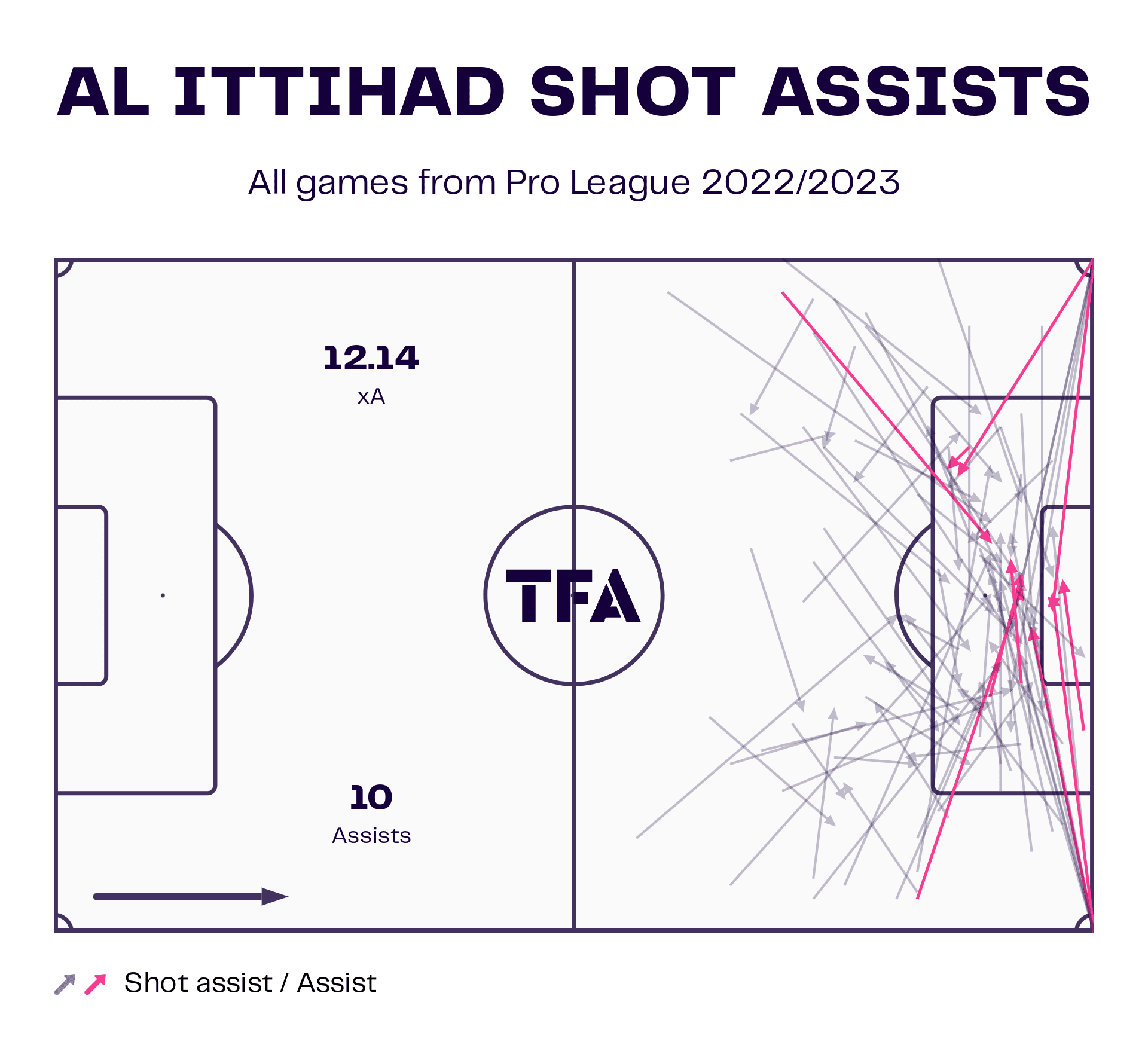
Al-Ittihad are quite flexible in the final third and are incredibly fluid, showing an ability to create chances from a whole variety of situations, hence why they are one of the highest goalscorers in the Saudi Pro League this season with 22 goals.
The Tigers are underperforming their xG, but only slightly, and so it is not a cause for concern at the moment unless the underperformance gap widens significantly.

Risky defending
As has been spoken about countless times in this piece, Nuno Espírito Santo is still regarded in Europe as a conservative coach, particularly out of possession.
But at Al-Ittihad, we are seeing a whole different approach to the defensive phase from the manager and one that has been quite successful early into the campaign. Al-Ittihad have conceded just six goals and are joint with league-leaders Al-Nassr for having the best defensive record in Saudi Arabia’s top-flight.
A new development from Nuno in the Middle East has been his approach to defensive transitions. Al-Ittihad are extremely risky when these situations occur, and the manager wants his side to throw all their eggs into one basket by counterpressing high up the pitch instead of dropping back into a solid defensive block as was common during his time in English football.
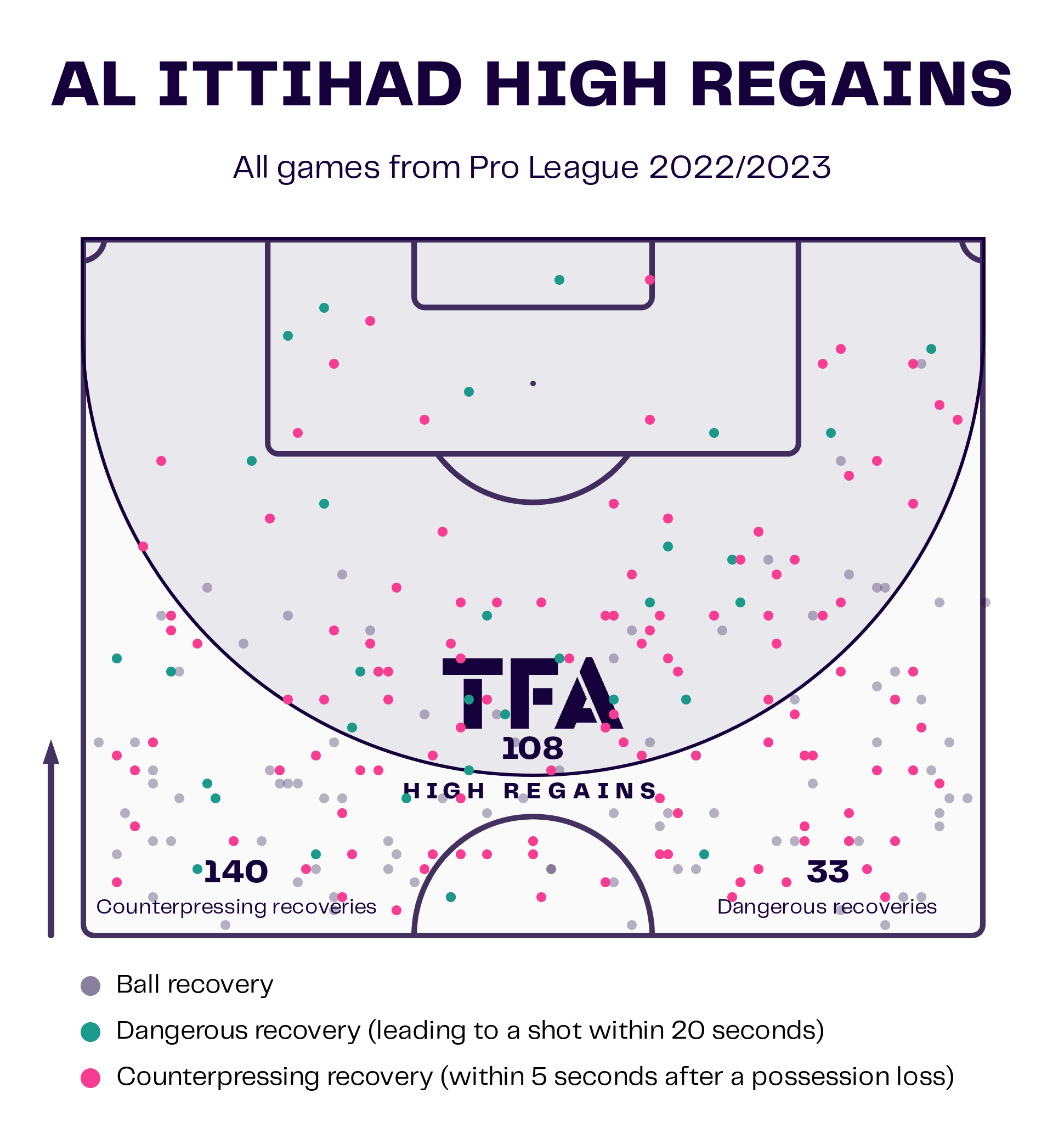
Al-Ittihad have registered 140 counterpressing recoveries in the league this season in the opposition’s half of the pitch.
The side’s high volume of successful counterpressing recoveries are a direct result of the wide overloads that they create. Keeping the ball in this area allows Al-Ittihad to contain the opposition out wide once possession is turned over, using the touchline as an extra defender to control the space and limit their passing angles and options.
Even the centre-backs step up to squeeze the pitch as much as possible, sitting close to the final third.
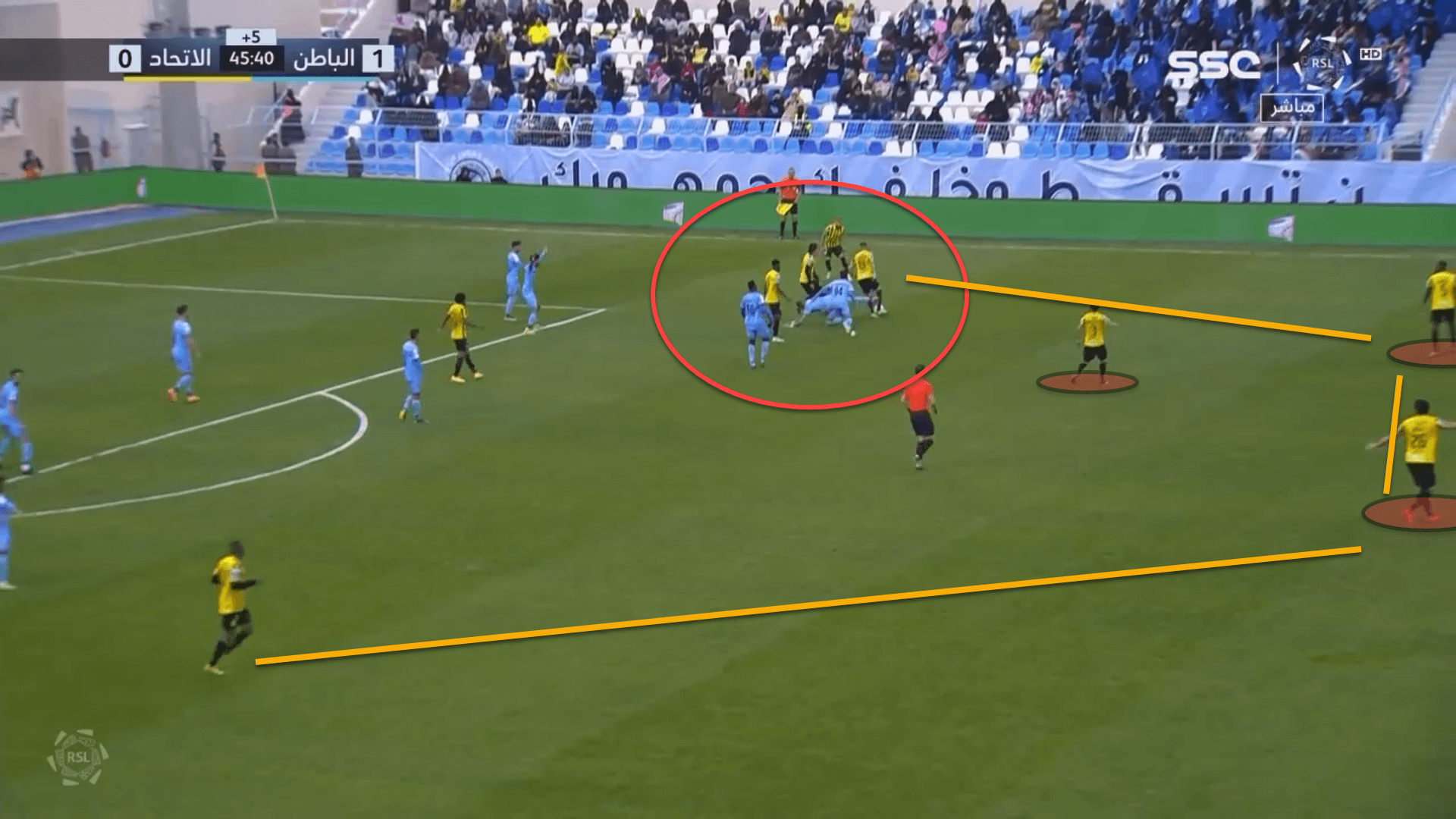
Of course, this a risky tactic by Nuno, far riskier than anything he had attempted in English football, particularly because Al-Ittihad leave just two men back which can lead to problems if the initial counterpress is broken in the final third.
Teams have exploited that this season. If the opposition leave at least two men forward, they can create a 2v2 situation against Al-Ittihad’s centre-backs in transition, with acres of space to play into.
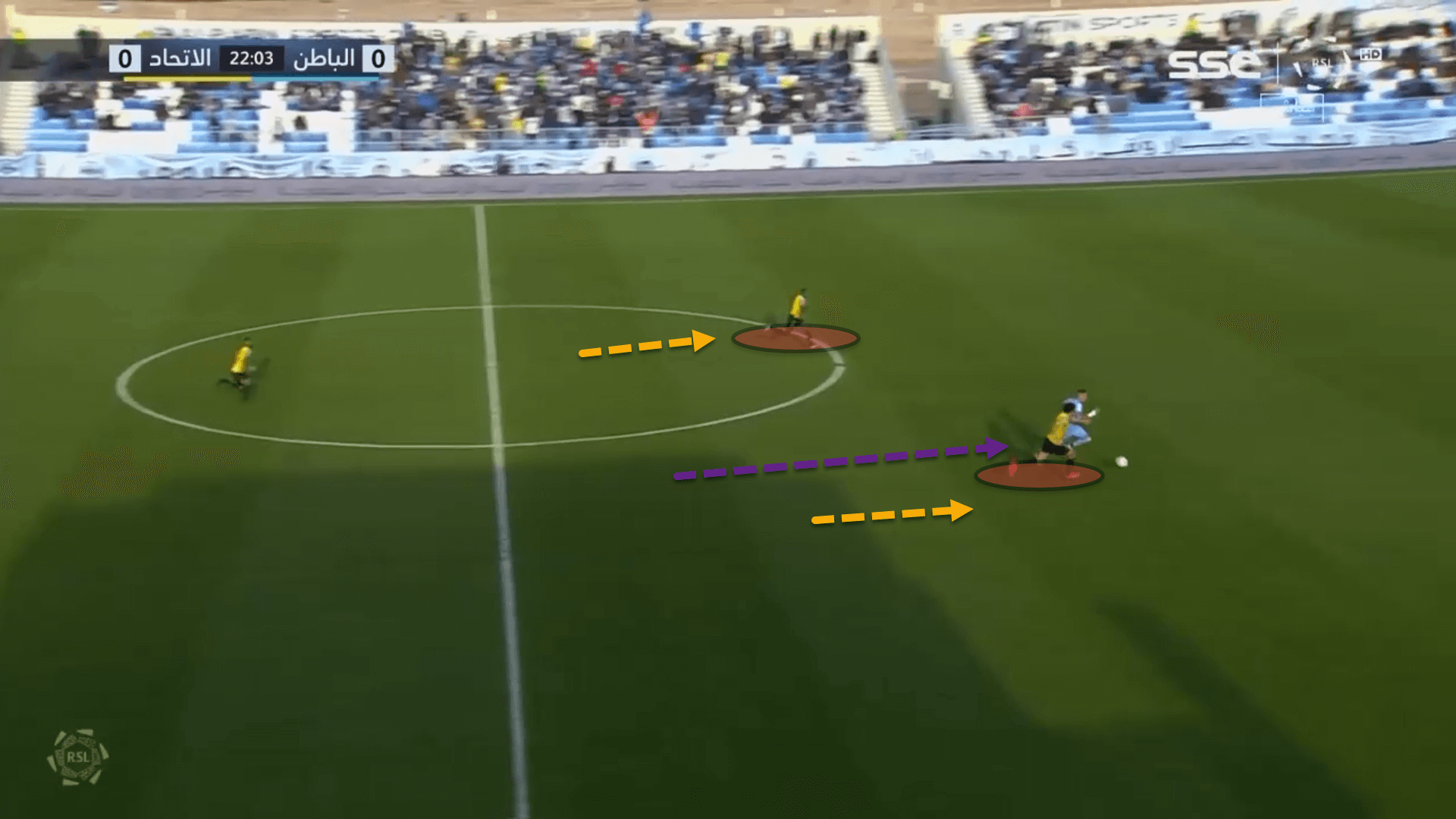
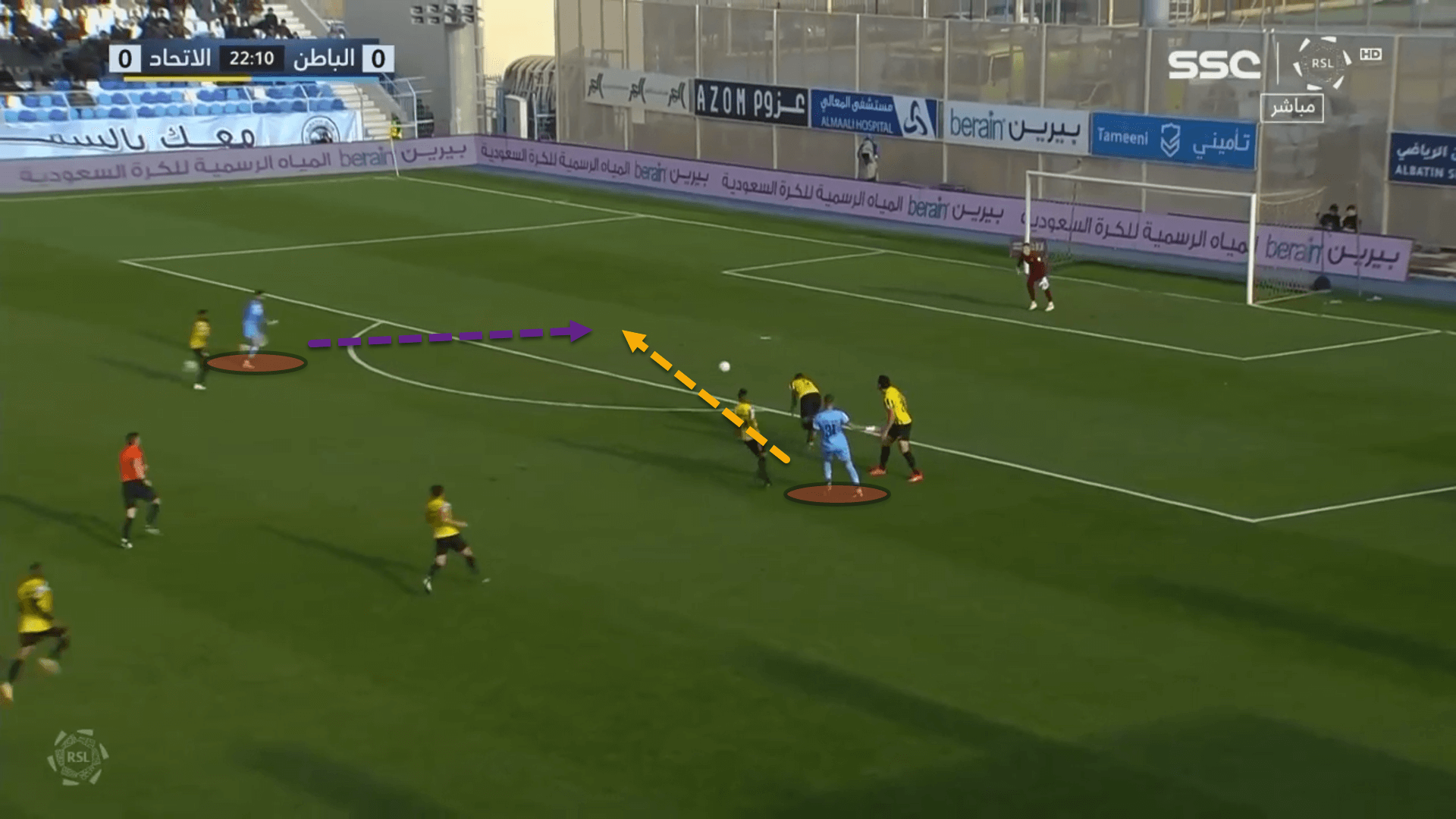
In this example, Al-Batin fully exploited Al-Ittihad’s risky rest defence structure. Initially, they had one centre-forward going it alone up top who did well to get between the centre-backs, but once he was supported by a teammate making a deep run, it was too late for Nuno’s team to stop the transition and Al-Batin took the lead.
Lower down the pitch, Al-Ittihad sit in a 4-4-2 zonal defensive block when the opposition establishes possession. The defensive scheme used by Nuno is one that can be manipulated by the opposition, especially out wide.
The wingers in particular are susceptible to manipulation. Nuno tasks his wingers with marking the opponent’s fullbacks. The height of the wingers depends on how high up the pitch these fullbacks sit.
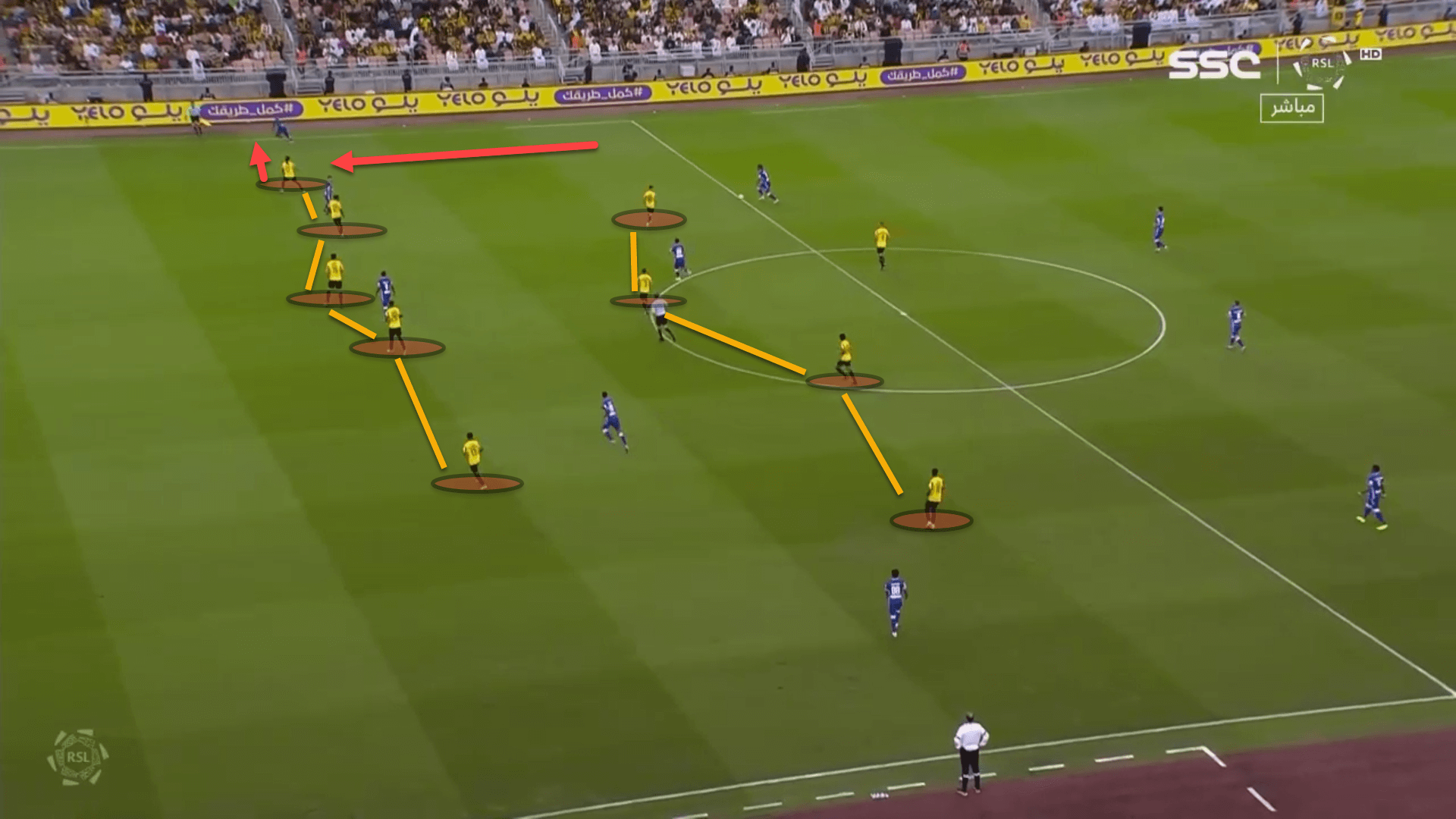
Here, we can see the left-winger, Helder Costa, dropping into the backline to create a five-man defence as Al-Hilal’s right-back has advanced up to the last line.
The tactic is quite simple in this regard. The Al-Ittihad fullbacks mark the opponent’s wingers, and the wingers stay close to the opponent’s fullbacks.
A problem that arises from this is when the fullback drops lower down the pitch, causing the nearest winger to follow them. This can often lead to the fullback being left in 1v1 situations.
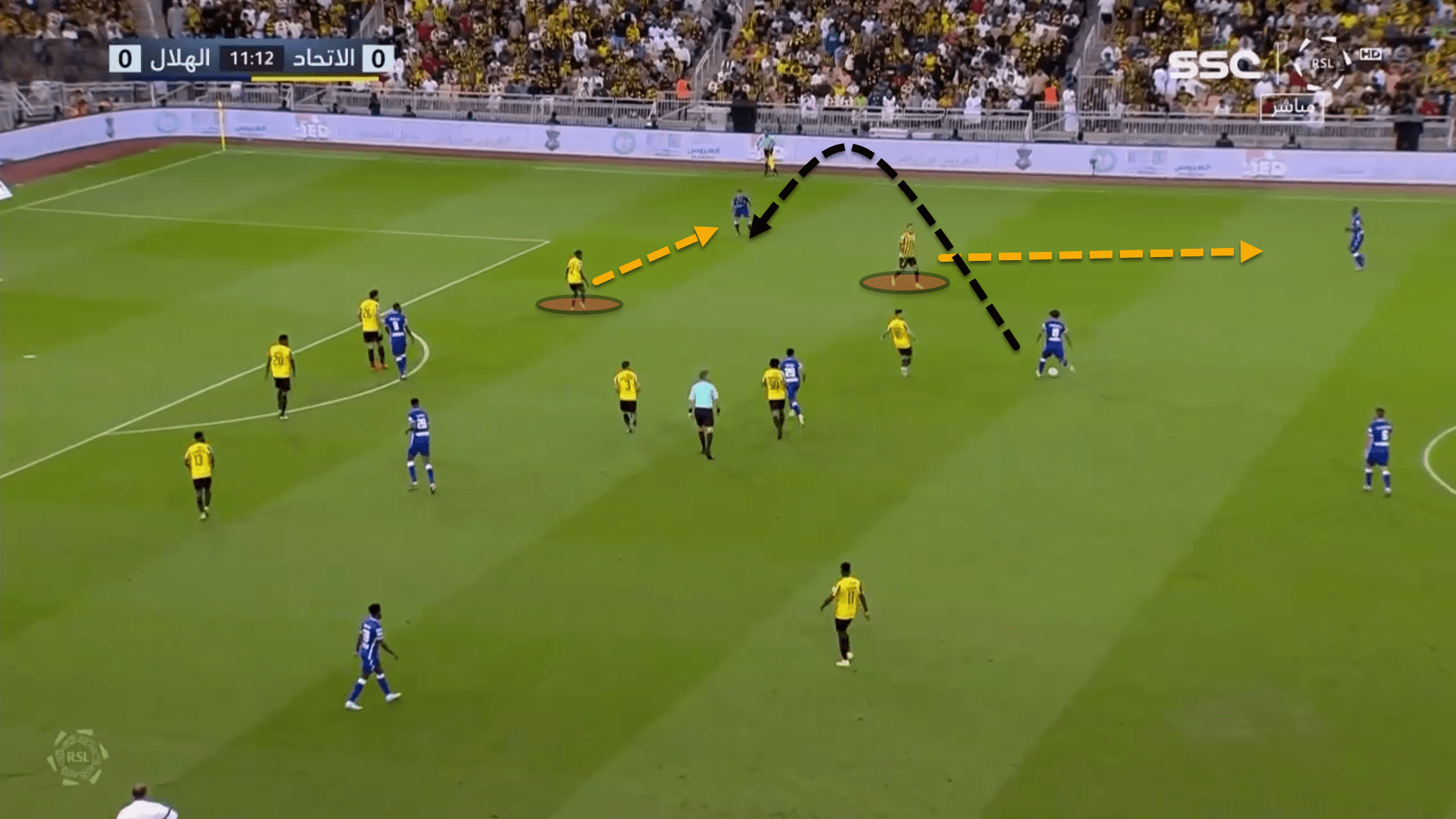
Al-Hilal killed Al-Ittihad in the first half of their recent league clash by using this to their advantage. Costa would follow his man deep on the left. Once this occurred, Al-Hilal would quickly play into the channel to the right-winger, allowing him to get 1v1 with his man.
If the fullback didn’t win the defensive duel, Nuno’s side found themselves in a lot of trouble. The hosts took the lead from this very situation as the left-back was beaten by his man which allowed the wide player to cross low into the feet of former Manchester United man Odion Ighalo who poked home what turned out to be the winner.
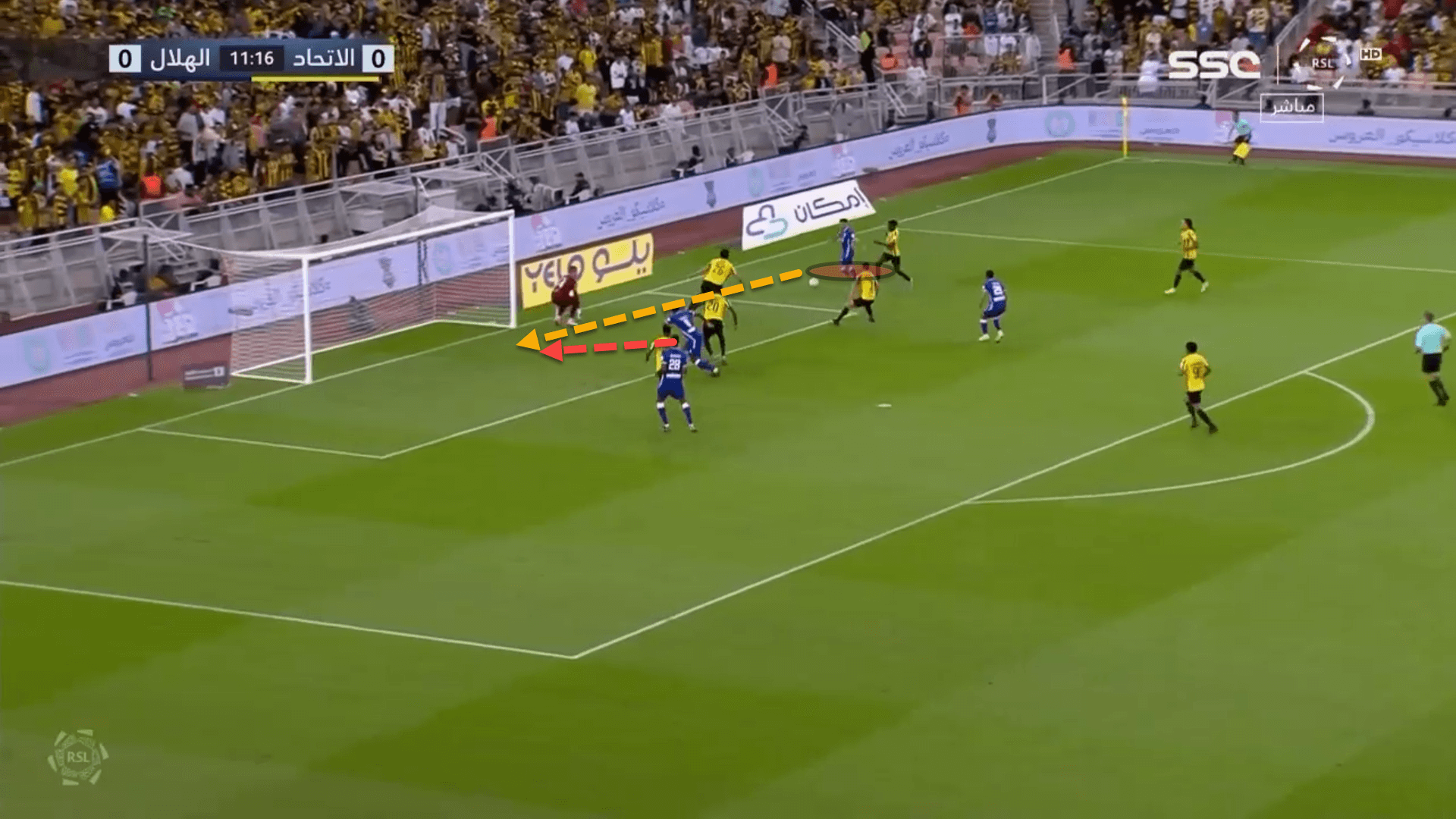
Regardless, Al-Ittihad are normally really secure at the back, which has allowed Nuno to be a little more expansive with his tactics in possession.
Conclusion
Now into the final of the Saudi Super Cup, having beaten Al-Nassr on Thursday, while sitting just a few points behind Rudi Garcia’s side at the top, it’s shaping up to be a very good season for Al-Ittihad under the guidance of Nuno Espírito Santo.
Nuno has completely reinvented himself in Saudi Arabia which could make him a tasty option for Premier League clubs who may have been slightly more hesitant to appoint the 48-year-old prior to his time in the Middle East.






Comments